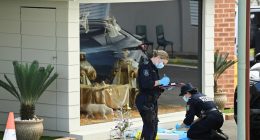
Mahalo for supporting Honolulu Star-Advertiser. Enjoy this free story!
Can wastewater from Hawaii’s sewer systems help forecast the imminence of future COVID-19 variants of concern?
That is the question University of Hawaii at Manoa researchers are trying to answer, and so far they’re pretty confident the answer is yes.
UH researchers led by Tao Yan, a professor in the Department of Civil and Environmental Engineering, are analyzing wastewater collected from Oahu during the pandemic to determine if the presence of a mutation could be an indicator of virus evolution.
During the onset of the COVID-19 pandemic in 2020, Yan and his team partnered with the City and County of Honolulu to collect wastewater samples.
From June to December 2020, the team collected 13 samples from the Sand Island Wastewater Treatment Plant and analyzed them in a UH laboratory. Using sequencing technology, the team developed specific methods to look more closely at specific mutations.
They found that one particular mutation — the D614G mutation — was the most prevalent in those samples.
According to Yan, the D614G mutation has so far been found in 15 COVID-19 variants of concern, including alpha, beta, delta, epsilon, eta, gamma, iota, kappa, lambda, mu, omicron BA.1, omicron BA.2, omicron BA.3, theta and zeta.
The team detected the D614G mutation in wastewater before it was found in health clinic test specimens.
Yan and his team believe the detection of mutations such as D614G in wastewater samples can be an indication that the virus continues to evolve and help forecast the emergence of new variants.
In April 2020 Yan received a National Science Foundation grant of more than $150,000 for his project “RAPID: Determine Community Disease Burden of COVID-19 by Probing Wastewater Microbiome.”
At that time his team was tasked with developing a highly efficient concentration and detection method for the coronavirus in wastewater.
What they found during a five-week period in 2020, before, during and after the city’s lockdown, was that wastewater concentration levels from two treatment plants in Honolulu correlated with the rise and fall of COVID-19 cases in the community.
Yan concluded that wastewater could be a reliable indicator of the prevalence of COVID-19 in a community. The findings were published last year in Water Research, a peer-reviewed scientific journal covering scientific research on water quality and management.
“At the beginning of the pandemic we were more focused on (virus) concentrations in the wastewater,” he said. “Now we are trying to broaden the tool so we can do sequencing to detect mutations in the community.”
The coronavirus is shed in human feces and can be detected regardless of whether people have symptoms or not. The Centers for Disease Control and Prevention and many municipalities are monitoring the concentration of the coronavirus in sewer water to determine community infection levels.
Whole genome sequencing of wastewater samples also can determine which variants are present.
The state Department of Health is trying to set up its own wastewater testing program, which it previously announced would be up and running some time this summer.
The program is still a work in progress, according to DOH, although two fellows from the Association of Public Health Laboratories have recently come on board.
In the meantime, DOH has enrolled 15 sewer sites statewide in the CDC’s National Wastewater Surveillance System.
CDC contractor Biobot Analytics collects and analyzes wastewater samples from 500 communities across the U.S., including Hawaii. The data is posted online on CDC’s wastewater metric map.
“The difference is that we’re not running the samples here,” said DOH Health Director Dr. Elizabeth Char during her appearance Friday on “Spotlight Hawaii,” the Honolulu Star-Advertiser’s livestream program. “The samples are being sent to the mainland and we’d like to be able to run it here because I think that would really shorten the turnaround time and get us some data a lot faster.”
She said the department is hoping to get its local testing program up soon.
Yan’s team, which includes postdoctoral researchers Doris Di and Bo Li, and graduate research assistant Min Ki Jeon, is also analyzing previously collected wastewater samples from within the Manoa Valley sewershed and UH student housing to determine if the SARS-CoV-2 viral mutations collected there are different from those collected from Sand Island.
The team continues to collect wastewater samples weekly from the Manoa sewershed and plans to continue as long as funding is available. Its goal is to establish a long-term wastewater surveillance program.
“If we’re successful we want to get this into a 20-year monitoring platform so we can look at how this virus itself evolves in our community,” he said, “and also use it to monitor the emergence of other pandemic strains.”
Yan plans to submit the team’s findings on the D614G mutation for publication in a scientific journal in September.
“This virus will continue to mutate, and some more ominous variants may emerge as a result,” Yan said. “Wastewater surveillance has the potential to provide comprehensive and even early detection of mutations. What we have done is to use past samples and data to develop and calibrate the tools, and the next step will be to use them for forecasting.”
Yan thinks the monitoring of wastewater has great potential for other pathogens as well.
He has studied wastewater in relation to foodborne disease outbreaks such as salmonella, and says it also can be used to monitor antibiotic resistance.
In New York, officials set up a wastewater surveillance system to track the coronavirus and the flu, and recently detected polio in the city’s sewage. New York also plans to monitor wastewater for the monkeypox virus.
“That is the beauty of molecular surveillance in wastewater,” Yan said. “You could potentially look at the method we use in those wastewater samples. We can use the same approach to target any pathogen that we’re investigating.”
Read More: World News | Entertainment News | Celeb News
Star Ads




